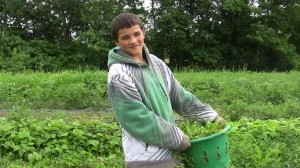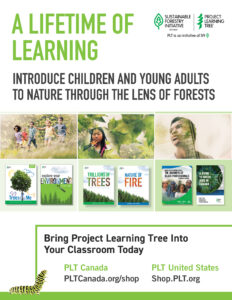Harvesting Life Lessons

Originally appears in the Spring 2015 issue
Since she was 14-years-old, Rayna Joyce has been rising early on summer mornings to plant lettuce and pull weeds with two dozen other teens who are learning as they grow. They are a part of the Youth Farm Project (YFP) that blends schools, community organizations, and farms into a nonprofit enterprise that’s starting its sixth growing season in 2015.
What began as a school garden is now a farm with ten acres of production land and a hands-on outdoor classroom where students grow food for the community. Last year, YFP harvested 11,500 pounds of organic vegetables, fed 3,000 people, and educated 100 teenagers. All of this was done with only one full-time manager and a handful of part-time paid staff.
Even better, teens emerge from the program with a clear understanding of our nation’s food system and how they can be part of healthier solutions. They learn about food equity, racism, and communication skills – while also having fun.
YFP leaders will be the first to tell you that their path wasn’t linear and they certainly weren’t well organized at the start. They shared ideas, tears, and hugs, felt panic, and persevered.
Let’s look at eight lessons they learned that could guide other educators planning to dig into a similar project:
- Find a place to set down roots
- Encourage young people to lead and mentor
- Use a farm or garden as your classroom
- Teach students to think globally, act locally
- Build market and community awareness
- Find partners who align with your goals
- As your program grows, grow your administrative structure
- Jump in and learn.
1. Find a place to set down roots
The Lehman Alternative Community School (LACS) in Ithaca, NY, is the alma mater for most of the Youth Farm Project leaders. From outside it looks a lot like other public schools set in small towns across North America. Inside the low brick building, however, things look a little different, starting with the walls covered in murals painted by students. The 300 students at LACS, grades six to 12, are assessed via narrative evaluations and portfolios – not grades – as part of the way they shape their own learning. Seniors graduate after completing a series of self-designed projects as well as community service.
Imagine this: it’s 2008 and Dan Flerlage, an ecology and molecular biology teacher, is inspiring his students to harvest garlic and haul compost at the small school garden. Teens bike to the school property over the summer to water plants and enter notes in a logbook. Flerlage is a charismatic mentor, described by at least one graduate as a “ladder” that students can climb. But even more influential, he encourages students to become ladders themselves.
When a school renovation project overtakes the current garden space, a former student finds land they can use on what becomes Three Swallows Farm a few miles away. So LACS turns its enthusiasm and philosophy toward the farm in the hopes of stepping beyond the school environment to involve the community, with all of its diversity.
Today YFP has a barn, tractor, washing station, cooler, chickens, and two hoop houses – unheated, polyethylene tunnels similar to greenhouses, where plants can be started and protected. This farm plus two others comprise a “CSA” (community-supported agriculture) called the Full Plate Collective. Community members buy shares in advance of the growing season that help farmers purchase seed and pay for other costs. In return, members receive a portion of the three-farm harvest each week throughout the season. On Fridays, many of the 500 shareholders pick up their fruits and vegetables at Three Swallows. As part of their shares, members harvest “self-service” style from the U-Pick rows of tomatoes, green beans, tomatillos, okra, herbs, and flowers that the youth farmers plant and tend.
2. Encourage young people to lead and mentor
Every summer, four crews form the backbone of YFP. Each crew consists of seven to eight members: two are college-aged crew leaders with Youth Farm experience, the others are teens. Roughly two dozen teens at YFP work on the farm four days a week from 9:00 a.m. to 1:30 p.m. On Wednesdays they meet at LACS to connect their hands-on learning to the broader context of food justice (everyone’s access to a healthy food supply) and community.
At the farm, tasks change daily and each crew tackles part of the list. If one group is weeding carrots, another might trellis tomatoes, the third prepares beds for fall crops, and the fourth might transplant kale. Everyone works each of the farm duties, rotating through the jobs of planting, watering, solving pest problems, monitoring crop nutrition, preparing lunch, being in charge of the chicken house, or hauling compost.
Crew leaders gain leadership skills by being responsible for the physical and emotional safety of their crew. As a part of this, they model positive communication. Rayna Joyce and Noa Wesley, both of whom have been involved in YFP since the beginning, say YFP encourages “Straight Talk,” a process developed by The Food Project (a non-profit in Boston that hires teens with the goal of creating personal and social change through sustainable agriculture). Straight Talk is communicating honestly about how you are feeling, making eye contact, listening, and learning how to receive feedback. Crew members frame comments into positives (“When we were trellising tomatoes and I needed extra twine, and you jumped and got it”) and deltas, or attributes that could be changed (“While we were weeding carrots this afternoon, you seemed to lack energy when we really needed you. It would be awesome for our crew if you could…”). Wesley, now a student at Cornell University, says, “We’re never really taught interpersonal communication anywhere in our system. That piece is a large part of what we do…and adds another level of depth.”
For YFP, emphasizing teamwork and engaging youth as active participants in the food system is a step toward addressing the looming crisis of America’s farming population, which is “aging out” faster than young farmers are entering the field. It also takes as its focus the pressing issue of young farmers struggling for the capital required to succeed.
“Another problem we’re hoping to address,” says Wesley, “is the dissonance between rural and urban, and between people of different socio-economic statuses. We’re getting young people of different backgrounds and having them relate to each other.”
Becoming more self-assured is a huge benefit of the program. Joyce, now a senior at LACS, says, “The whole experience helped me come out of my shell. I was a lot less confident before, and the farm had a big impact on me feeling empowered. Having to be in a leadership role, I knew what I was doing and could explain farm tasks… That’s why our program has worked. It’s actually youth led.”
3. Use a farm or garden as your classroom
The hands-on nature of growing food in a garden or farm works its own kind of magic. Young people gain practical vegetable farming skills by handling trowels, hoes, shovels, and irrigation systems. “My best day of being a teacher,” says Flerlage, “using activities, writings, whatever else I could think of, doesn’t hold a candle to a bunch of folks working with common purpose in a field. You’re totally together, and differences dissipate.”
To learn about soils, crews dig soil pits, watch how sand, silt, and clay separate in a glass jar, discuss different scenarios for using cover crops on the farm, and learn how local soils were affected by glaciation. They talk about organic matter, crop rotation, fertilizing, and managing insects and diseases. They may even have a scavenger hunt for different plant families.
Ann Piombino, full-time manager for the Youth Farm, summarizes: “A lot of what we do in the summer program is to build up basic skills: teambuilding, communication, learning how to be with each other…so they can apply it to their lives. When we say, ‘This is how you plant a plant, and how you take care of it so it doesn’t die,’ the whole farm becomes a metaphor for learning responsibility.”
4. Teach students to think globally, act locally
At the Youth Farm, students begin to think globally but also realize they have the power to act locally. During Wednesday’s Development Days, they put their farm knowledge into the larger context of human health, food justice, systemic racism, and sustainable agriculture.
Conceived by the director of a downtown community center, Development Days brought leaders of different ethnicities together to plan. They began inviting guest speakers and drawing on Youth Farm leaders to teach about all aspects of food. Today teens learn about migrant labor, the Real Food Wheel, and the relationship between type 2 diabetes and diet. Students play games that encourage them to think about the effect of climate change on our food system and require them to make choices as if they owned a farm.
Staff admit that planning these days while also running the farm is time consuming and a challenging part of the program. But as Amsili says, “That’s what sets the Youth Farm apart.” (For details on educational topics, both on and off the farm, see the sidebar).
Every Wednesday at lunch, a local chef teaches the group how to prepare a meal from seasonal vegetables, and later the students practice making the dish. At the season’s end, students create a dinner based on recipes they learned from the chefs and invite their families for a feast.
5. Build market and community awareness
What happens to the 11,500 pounds of vegetables harvested annually? Some of the carrots, radishes, peas, broccoli, and other veggies become daily lunch for the crews. Produce is also delivered to two community centers, the local charter school, and an elementary school for lunches, snacks, and special events. In addition, students sell regularly at ongoing farmers’ markets and a few “pop up” markets each year. Certain vegetables are wholesaled to local restaurants and distributors.
The big buyer – in terms of quantity – is the local public school district, which uses the vegetables for their student, staff, and faculty lunch program. These lucky students graze daily over a salad bar of fresh greens, radishes, brown rice, chick peas, shredded beets, carrots, and baked tofu.
Although the core mission of the Farm is to involve youth in making their local food system more equitable, food is not the only product of YFP. The educational opportunities are valuable to regional schools on field trips, student committees doing special projects, youth groups, and the college students who receive credit for working with youth on the farm.
6. Find partners who align with your goals
YFP has gradually built relationships with many partners that serve youth, creating a program that reaches kids from diverse backgrounds. From the beginning, YFP has had a goal of hiring 50 per cent young people of color, aged 14-18. Originally YFP staff worked to embrace this commitment to diversity themselves, but more recently local youth employment agencies have taken over this process. Today those partners hire and fund most of the two dozen teens who participate in the program.
Inviting everyone to become involved at all levels has been important. In 2014, at least 300 local volunteers – from the “Crop Mob” helping at the Farm on Saturdays, to the designer producing the annual report – tackled dozens of different tasks. The value of in-kind donations last year, including labor, professional work, land, farm products, materials, utilities, equipment loans, and storage space, was $90,000.
At least 30 different federal, state, and local entities partner with YFP. Social Ventures (a nonprofit umbrella) provides administrative support at no cost. The Natural Resources Conservation Service awarded one grant to spiff up the barn and another to build a hoop house. Area colleges provide interns, Ithaca Waldorf School leases the farmland at no cost, the countywide bus system subsidizes transportation, and the Service Collaborative of Western New York offers VISTA positions. Additionally, area farms encourage gleaning of fruit so students can make currant-raspberry-jalapeño jam and the NYS Food Venture Center opened its kitchen for testing and improving the Farm’s jam and salsa recipes.
7. As your program grows, grow your administrative structure
When YFP first applied for funding from a local foundation, they asked for close to $9,000 and got it. Flerlage remembers thinking they would never need that much money, but sure enough, they did. In the past six years, YFP has increased both its budget and the staff needed to oversee the program.
By 2013, YFP’s $75,000 revenue pie could be divided into three pieces: 11 per cent from food sales, 20 per cent from foundations (e.g., the Park Foundation and Howland Trust), and 69 per cent from private donations and business sponsors. Because 2013 expenses totaled $48,000, the project could carry over funds and hire a full-time manager, an administrator (15 hours a week), an assistant farmer, and several youth coordinators. At the end of 2014, YFP contracted a grant writer who has continued to leverage their resources.
YFP now has a board of directors and state nonprofit status, with staff now working on obtaining federal 501(c)3 status. Their vision is to be able to pay key staff rather than rely on volunteers, and they’re edging toward that goal.
8. Jump in and learn
People involved in YFP tend to learn by doing. Flerlage has worked days, nights, and weekends to pull off the project. He’s honest about how YFP jumped in, not knowing what they were doing, and were surprised by logistics. He still remembers thinking, “Whoa! I didn’t know we had to have insurance! A Porta John? Rain gear?”
But in the same breath, Flerlage waxes philosophical: “The tendency to underestimate young people is profound. A high percentage of the kids sent to us would have a hard time elsewhere. The Farm is the antithesis of one-size-fits-all. Part of it is the staff and a culture that values things broadly and provides experiences that allow people to shine.”
What to teach
Topics for Development Days and On-Farm Education
How-to’s for many of these activities can be found in the Food Project’s Summer Youth Program, Volume 3: Implementation Manual (see Resources for a free download).
- Worker readiness: worksite orientation; attendance and attire; communicating with supervisors; interacting with peers; first aid/emergency protocols.
- Leadership development: presentation skills (to peer audiences at YFP, community groups, and conferences); giving farm tours to volunteers; how to take on and handle challenges; time management.
- Team-building: group problem-solving; cooperation; communication Straight Talk (practiced weekly).
- Anti-racism: racism in our community, the food system, and society at large; determine what a judgment is, the pro’s and con’s of belonging to a group, privilege, and how to work toward connecting with everyone in the community.
- Food systems: migrant farmers’ rights; diet-related health issues; Bill Nye science video clips; limitations to food access; local food systems vs. national/global food systems; sustainable agriculture vs. conventional agriculture.
- Farm planning: preparing for and planting early hoop house crops; field planting; maintenance; harvesting sequencing and scheduling; food handling; food safety; OSHA safety; equipment maintenance; visits from local youth programs; coordination with daily Farm activities.
- Farm enterprise: budgeting; profits and losses; marketing; money management; entrepreneurial skills; payroll; math; event planning and coordination; fulfilling local contracts with quality management principles.
- Cover crops: distribute fact sheets on different cover crops and scenarios at the Farm broadcasting seed with youth (do early, so youth can see the results); dig up red clover to see root nodules.
- Culinary: cooking; canning; preserving; healthy eating habits; creating and testing value-added products, such as jam and salsa.
- Soils: The apple and its skin as a simile for the soil around the Earth; soil texture in a jar; dig a soil pit; tillage techniques, tractor tools and why they are used.
- Sustainable agriculture: Permaculture basics; composting; crop families; Three Sisters garden and the Haudenosaunee landscape; bee hives; egg and meat poultry production; weed I.D; harvesting and post-harvest storage techniques for vegetables.
To view the photo-rich magazine version, click here.
If you are not already a subscriber, please subscribe to read the full article
Carrie Koplinka-Loehr is a freelance writer in Lansing, New York, who has a Masters degree in science education.
Resources
The Food Project: http://thefoodproject.org, and in particular the 396-page Summer Youth Program, Volume 3: Implementation Manual, explains goals, games, activities, and logistics. Download for free: http://thefoodproject.org/sites/default/files/FoodProject_SYP3Manual_0.pdf
Growing Food and Justice for All Initiative has a helpful online glossary: http://www.growingfoodandjustice.org/Glossary.html
Massachusetts Avenue Project, Buffalo, NY, http://mass-ave.org/ has a Growing Green Program: youth development and urban agriculture focused on healthy food access and improving communities.
Real Food Wheel (producers, consumers, earth, and communities): http://www.slideshare.net/cfsc/real-food-wheel-11300113
The Youth Farm Project, http://www.youthfarmproject.org, has a blog, photos, and annual reports.
Leave a Reply
You must be logged in to post a comment.





